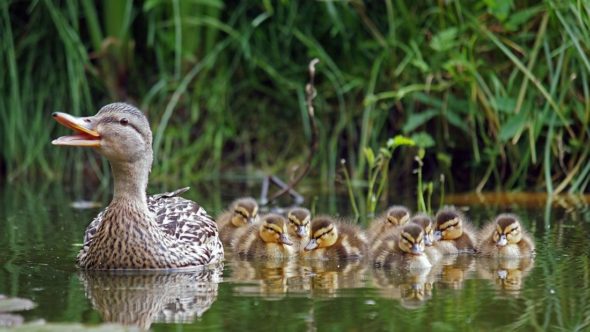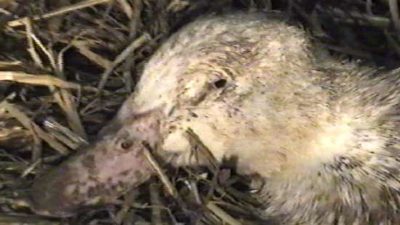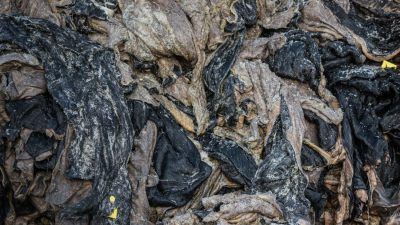Down feathers
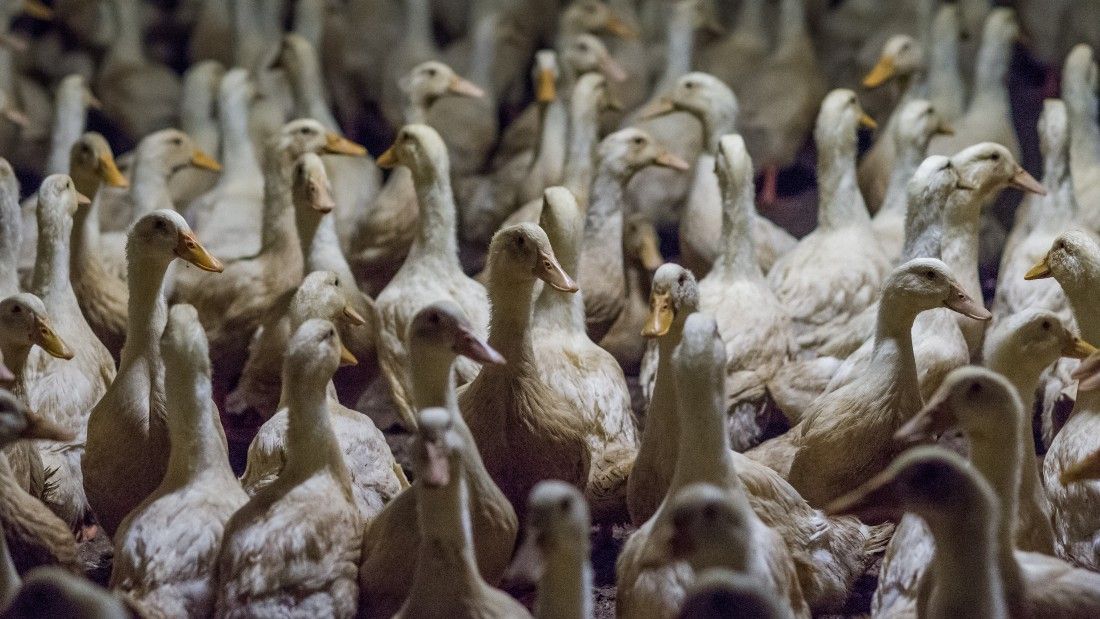
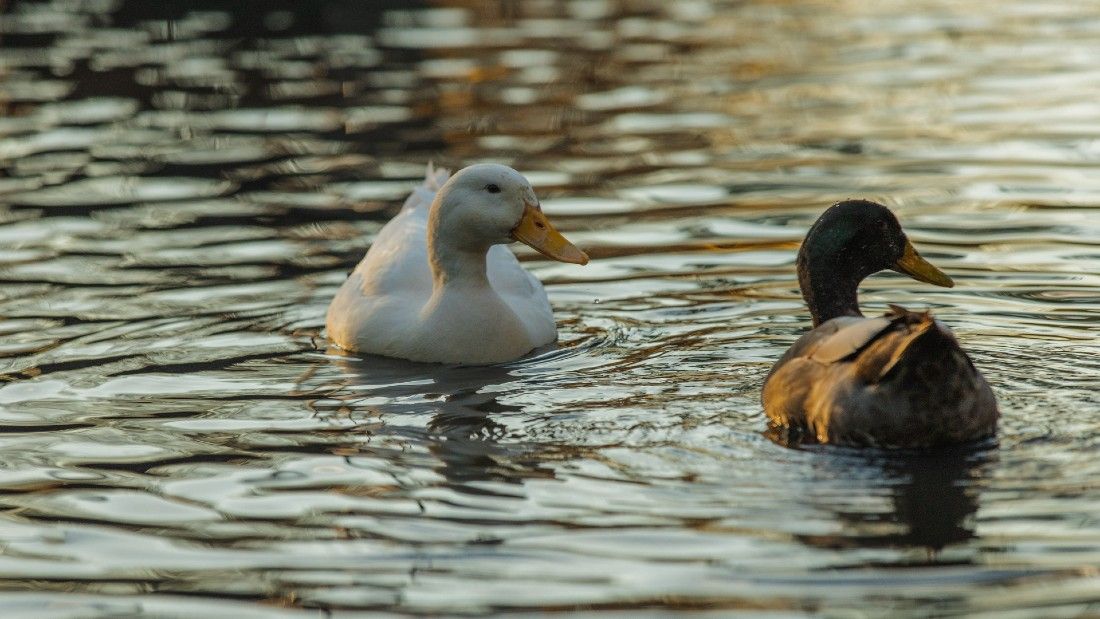
Down is the layer of soft undercoating found beneath the more streamlined and rigid outer layer of feathers on waterfowl such as ducks, geese and swans, usually on the chest, stomach and flanks. Young birds are covered exclusively in down, which gives them their infamous cute and fluffy appearance, until their outer feathers grow.
Unlike feathers, down doesn’t have a quill but “is composed of thousands of individual fibers formed together in a three dimensional cluster”.2The American Down and Feather Council. Frequently Asked Questions. Home Fashion Products Association. Available at: https://downandfeathercouncil.com/what-is-down-feather/frequently-asked-questions/ [Accessed 14 Jan 2021].
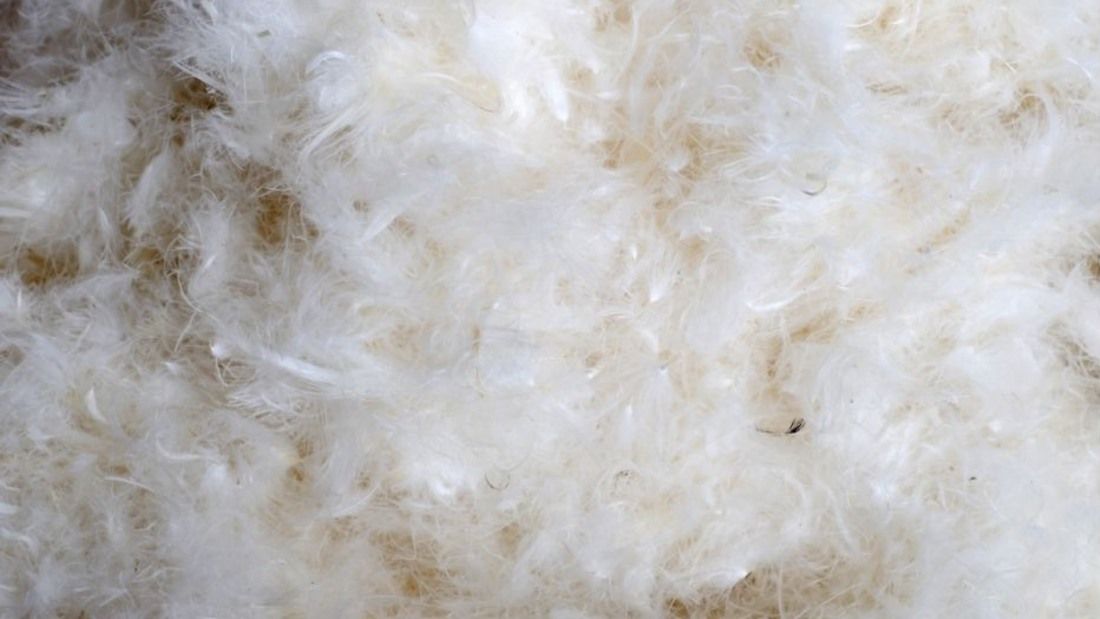
Down has naturally evolved to trap air and insulate birds against the cold. It is also hygroscopic so absorbs some moisture, such as from perspiration and the breath, releasing it later on.2Kozak, J., Gara, I., & Kawada, T. 2010. Production and welfare aspects of goose down and feather harvesting. World’s Poultry Science Journal, 66(04), 767–778.
When humans became aware of down’s role as a thermal insulator, we started using it for our own purposes. The most common uses for down are: pillows, duvets, sleeping bags and winter jackets.


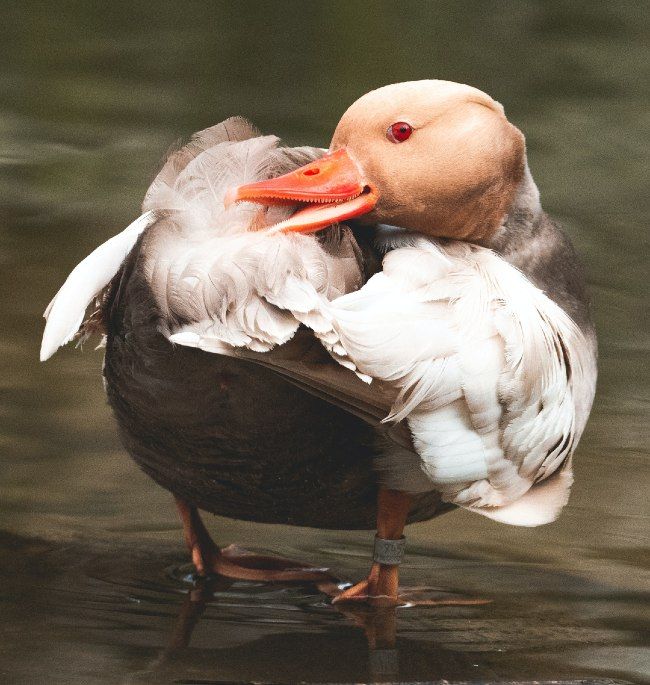 The animals most commonly farmed for down are ducks and geese.
The animals most commonly farmed for down are ducks and geese.
‘The largest duck and goose producer is China with 65% and 94% of the world production, respectively.’3Pingel, H. 2009. Water Fowl Production for Food Security. IV World Waterfowl Conference, 11-13 November,2009. Available at: http://www.waterfowl2009.vetcos.com/proceedings%20-%20IV%20WWC%20-%20Kerala,%20India.pdf [Accessed 14 Jan 2021]. Because duck and goose meat is so popular in China, it also means it produces and exports the most down.
Although technically a by-product of the meat, organ (foie gras) and egg industry4EFDA. Feathers & Down. EFDA. Available at: https://edfa.eu/feathers-down/ [Accessed 14 Jan 2021]., down plays a significant part in economically sustaining these exploitative businesses.5RSPCA Knowledgebase. 2019. What are the animal welfare concerns with the production of down (feathers)? RSPCA Australia. Available at: https://kb.rspca.org.au/knowledge-base/what-are-the-animal-welfare-concerns-with-the-production-of-down-feathers/ [Accessed 14 Jan 2021].
Down is “obtained at the time of slaughter as a valuable by-product. The harvesting of feathers and down from live ducks and geese during the partial moulting at intervals of about seven weeks can be an additional source of income from fattening geese kept on pastures beyond 22 weeks of age and from breeding or laying ducks and geese in small-scale farms.”3Pingel, H. 2009. Water Fowl Production for Food Security. IV World Waterfowl Conference, 11-13 November,2009. Available at: http://www.waterfowl2009.vetcos.com/proceedings%20-%20IV%20WWC%20-%20Kerala,%20India.pdf [Accessed 14 Jan 2021]. The Food and Agriculture Office (FAO) claims that the live plucking of geese is an important source of income for those breeding the birds.6FAO. Chapter 10: Feather and Down Production. FAO. Available at: http://www.fao.org/3/y4359e/y4359e0c.htm [Accessed 14 Jan 2021].
Many geese and ducks are kept alive longer than if they were just raised for meat, so that they can be plucked more than once. Their lives might be longer but they are full of misery. This shows that the profitability of down affects industry practices, i.e. the way the birds are farmed, and is therefore more than just a by-product.
Even though these birds are also used for meat and organs, if demand and profit was high enough, there is no doubt they would be farmed primarily for their down – as cows are specifically farmed for their skin in India.
The down is taken from ducks and geese either after they are slaughtered, or several times while they are still alive.
To find out how ducks are farmed for meat, click on the link below:
Post-slaughter
For the ducks and geese who have their feathers removed after slaughter, their lifeless bodies are scalded in hot water for between one to three minutes. The coarser wing and tall feathers are then removed by hand before the down is ripped out by either hand or machine.1FAO. Chapter 10: Feather and Down Production. FAO. Available at: http://www.fao.org/3/y4359e/y4359e0c.htm [Accessed 14 Jan 2021].
Because the down is likely to be stained with blood and excreta2Kozak, J., Gara, I., & Kawada, T. 2010. Production and welfare aspects of goose down and feather harvesting. World’s Poultry Science Journal, 66(04), 767–778., it has to be washed, tumble-dried and treated with various chemicals before being shipped to manufacturers.
Live plucking

Credit: Andrew Skowron
Technically there are two ways of taking down from live birds: “gathering” and “plucking”.
“Gathering” refers to removing down when the bird is naturally moulting, like removing loose hair from a dog. “Plucking” refers to pulling the down from the bird’s skin.
Gathering sounds harmless but in truth it is a traumatising experience for the birds. Even in gathering looser feathers, some are painfully plucked as feathers “ripen” at different times on different parts of the bird’s body. In these industrialised processes, hundreds of birds have their down removed at the same time and it is very unlikely that they are all at the same stage of moulting.3European Food Safety Authority. 2010. Scientific Opinion on the practice of harvesting (collecting) feathers from live geese for down production. EFSA Journal 2010; 8(11):1886. Available: https://efsa.onlinelibrary.wiley.com/doi/pdf/10.2903/j.efsa.2010.1886# Accessed 14 Jan 2021]. So, in effect, all birds are live-plucked, even if it is claimed that their down is gathered.
Down from live-plucked waterfowl is considered of higher quality than that from slaughtered birds.4Milman, O. 2016. ‘Ethical down’: is the lining of your winter coat nothing but fluff? The Guardian. Available: https://www.theguardian.com/world/2016/jan/14/winter-coat-ethically-produced-down-goose-feathers [Accessed 14 Jan 2021]. This is because down removed from dead birds is often contaminated with blood and excreta and therefore has to undergo a lot of cleaning which degrades the condition of the down.2Kozak, J., Gara, I., & Kawada, T. 2010. Production and welfare aspects of goose down and feather harvesting. World’s Poultry Science Journal, 66(04), 767–778.
Live-plucked ducks and geese often live longer5Gibson, K. 2016. A foul truth behind the down in pillows and comforters. CBS News. Available: https://www.cbsnews.com/news/a-foul-truth-behind-the-down-in-pillows-and-comforters/ [Accessed 14 Jan 2021]. but this is little consolation when the extra time on earth is just filled with more misery on a factory farm. The individuals who are live-plucked, not only have to endure the same cruel conditions as those killed first, but for longer and have their down ripped from their flesh more than once.
From the young age of nine to 10 weeks, the birds are “harvested” – or violently and intrusively exploited – every six weeks.1FAO. Chapter 10: Feather and Down Production. FAO. Available at: http://www.fao.org/3/y4359e/y4359e0c.htm [Accessed 14 Jan 2021]. As they grow in size, more down can be taken from them.2Kozak, J., Gara, I., & Kawada, T. 2010. Production and welfare aspects of goose down and feather harvesting. World’s Poultry Science Journal, 66(04), 767–778.
Of course, it’s not only the plucking that causes harm to the birds. First they have to be caught, carried and restrained, which can result in injuries such as “[b]loody feathers, skin injuries, posture changes (e.g. hanging wings), dead birds and broken or dislocated bones.”3European Food Safety Authority. 2010. Scientific Opinion on the practice of harvesting (collecting) feathers from live geese for down production. EFSA Journal 2010; 8(11):1886. Available: https://efsa.onlinelibrary.wiley.com/doi/pdf/10.2903/j.efsa.2010.1886# Accessed 14 Jan 2021].

According to the RSPCA, about 98 per cent of down is taken after slaughter and only one to two per cent is live-plucked.1RSPCA Knowledgebase. 2019. What are the animal welfare concerns with the production of down (feathers)? RSPCA Australia. Available at: https://kb.rspca.org.au/knowledge-base/what-are-the-animal-welfare-concerns-with-the-production-of-down-feathers/ [Accessed 14 Jan 2021]. In either case, the methods involved are totally inhumane.
The ducks and geese who are plucked after their death still face a nightmarish life on factory farms. Even if the process of removing down could be done humanely, the conditions in which the ducks and geese live, the transportation they have to endure, and their gruesome deaths in a slaughterhouse, ensure cruelty is present at every step.
And the truth is, the number of waterfowl who are live-plucked is probably much higher than one or two per cent. Investigations have shown that retailers are inexcusably oblivious to the practices in their supply chain.2Gibson, K. 2016. A foul truth behind the down in pillows and comforters. CBS News. Available: https://www.cbsnews.com/news/a-foul-truth-behind-the-down-in-pillows-and-comforters/ [Accessed 14 Jan 2021].
In theory, only loose feathers ready to moult are supposed to be removed or “gathered” but plucking “results in bleeding follicles and possibly other skin damage such as tears and bruising.”3European Food Safety Authority. 2010. Scientific Opinion on the practice of harvesting (collecting) feathers from live geese for down production. EFSA Journal 2010; 8(11):1886. Available: https://efsa.onlinelibrary.wiley.com/doi/pdf/10.2903/j.efsa.2010.1886# Accessed 14 Jan 2021]. The EFSA’s Panel on Animal Health and Welfare concluded that: “suffering from pain and injuries is unavoidable under current commercial conditions” where “[t]he pressure on those collecting feathers to get as many feathers from as many geese as possible, in a short period of a time, results in feathers being plucked.”3European Food Safety Authority. 2010. Scientific Opinion on the practice of harvesting (collecting) feathers from live geese for down production. EFSA Journal 2010; 8(11):1886. Available: https://efsa.onlinelibrary.wiley.com/doi/pdf/10.2903/j.efsa.2010.1886# Accessed 14 Jan 2021].
In a capitalist system where animals are viewed as a means to make money, their welfare will always be compromised. This is why the only answer is to go vegan and avoid all animal products.

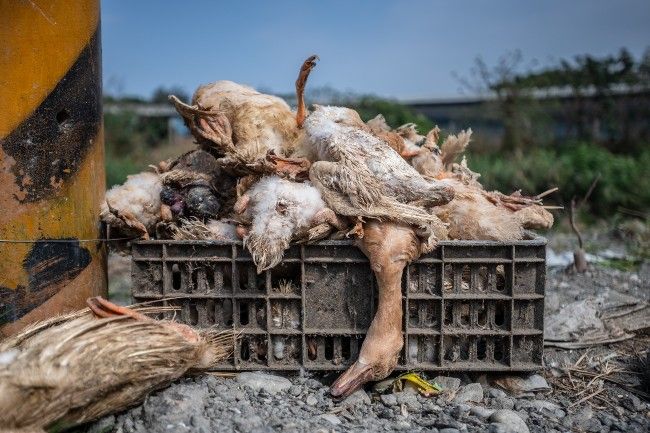
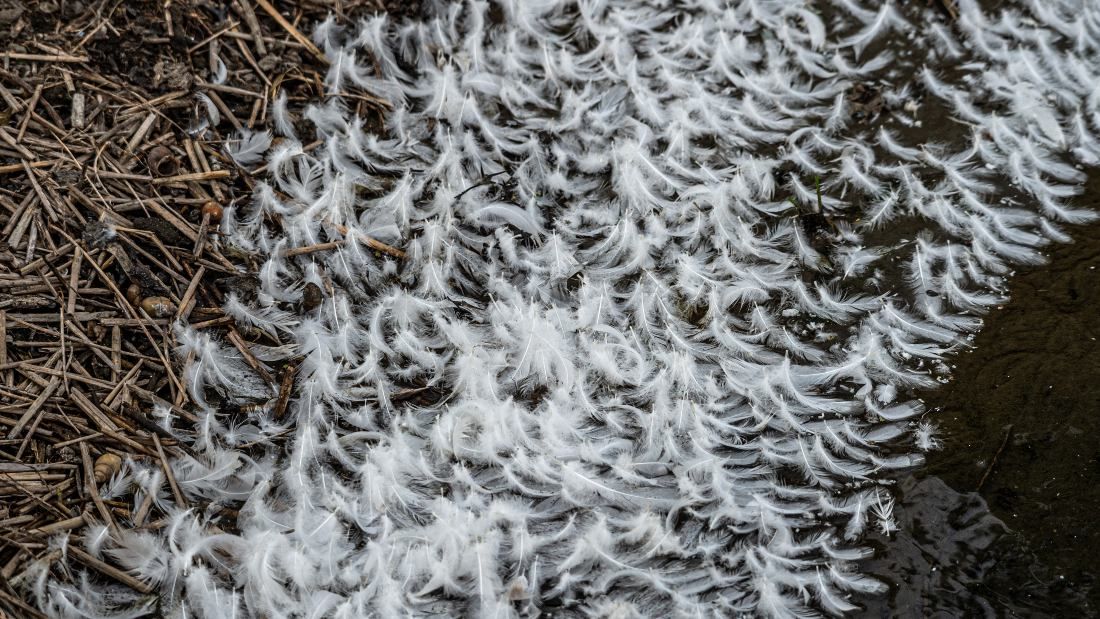
Because down is a natural material, like leather and fur, the industry claims it is environmentally friendly and sustainable:
“… approximately 2.7 billion ducks and 653 million geese were raised for consumption globally from 2009-2013, resulting in an estimated 410 million pounds (186 million kilograms) of excess down and feathers each year. These materials, which would otherwise serve only as a waste product, are then cleaned and sanitized for use in products like pillows, comforters, duvets, mattress toppers, winter jackets and outdoor sports gear, instead of contributing to worldwide landfill issues.”4The American Down and Feather Council. Industry Statistics & Practices. Home Fashion Products Association. Available at: https://downandfeathercouncil.com/for-consumers/industry-statistics-practices/ [Accessed 14 Jan 2021].
Of course, this ignores all the environmental damage caused by the factory farming of three million ducks and geese annually for their flesh. In addition, actually stopping eating ducks and geese would be an even better way to solve the landfill problem.
But also like the leather and fur industry, down doesn’t reach the consumer without first being treated with hazardous chemicals.5Kawada, T., Kuroyanagi, J., Okazaki, F., et al. 2019. An Integrative Evaluation Method for the Biological Safety of Down and Feather Materials. International Journal of Molecular Sciences. 20(6):1434. Available: https://www.ncbi.nlm.nih.gov/pmc/articles/PMC6471580/ [Accessed 14 Jan 2021].
Allergies to down and feathers are rare but “the number of patients suffering from adverse health effects caused by these products, including ‘Down Pillow Allergy Symptoms’, is increasing.”5Kawada, T., Kuroyanagi, J., Okazaki, F., et al. 2019. An Integrative Evaluation Method for the Biological Safety of Down and Feather Materials. International Journal of Molecular Sciences. 20(6):1434. Available: https://www.ncbi.nlm.nih.gov/pmc/articles/PMC6471580/ [Accessed 14 Jan 2021]. Down provides a breeding ground for bacteria and dust mites, which commonly cause allergies, so one chemical used is anti-microbial to prevent bacterial growth. Another group of glue-like chemicals are used to make down feel heavier and more substantial.5Kawada, T., Kuroyanagi, J., Okazaki, F., et al. 2019. An Integrative Evaluation Method for the Biological Safety of Down and Feather Materials. International Journal of Molecular Sciences. 20(6):1434. Available: https://www.ncbi.nlm.nih.gov/pmc/articles/PMC6471580/ [Accessed 14 Jan 2021].
These chemicals, “pose a serious threat to the health of consumers.”5Kawada, T., Kuroyanagi, J., Okazaki, F., et al. 2019. An Integrative Evaluation Method for the Biological Safety of Down and Feather Materials. International Journal of Molecular Sciences. 20(6):1434. Available: https://www.ncbi.nlm.nih.gov/pmc/articles/PMC6471580/ [Accessed 14 Jan 2021]. Some brands are now also treating down with a hydrophobic compound to stop it absorbing moisture.
Considering how much time we spend beneath our bed sheets, do we really want to be lying in hazardous chemicals?
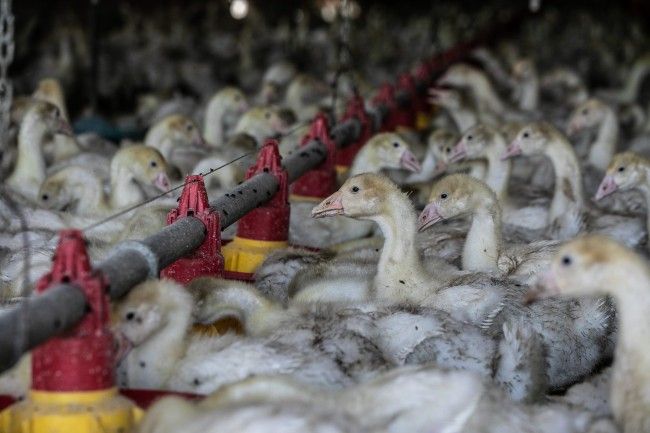

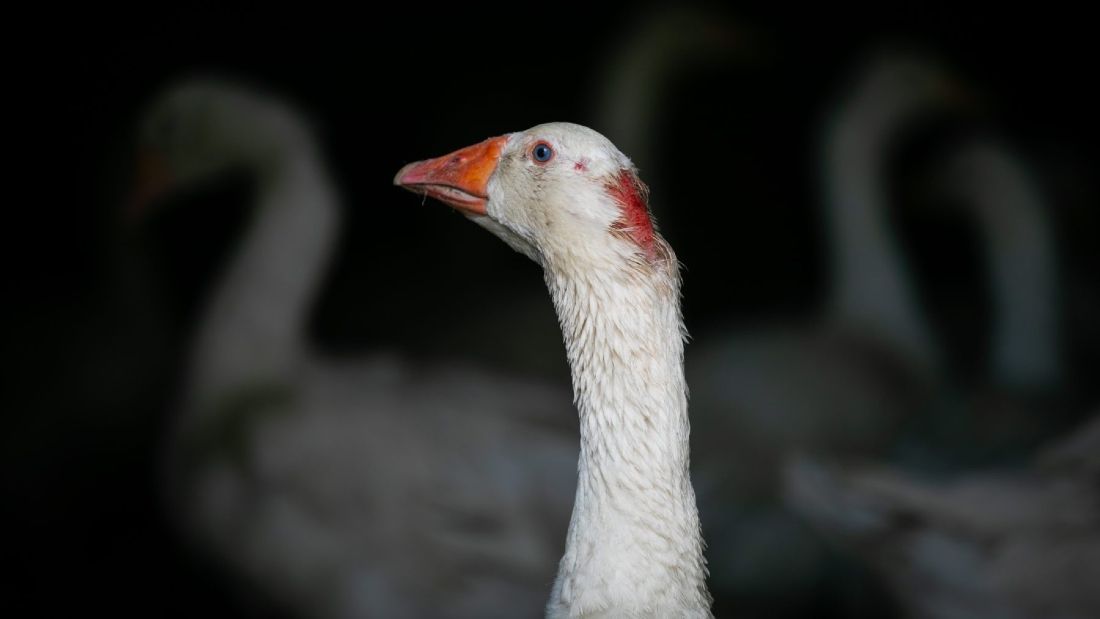
Although EU law prohibits the live plucking of ducks and geese, and Hungary only allows it when the birds are moulting,6Kozak, J., Gara, I., & Kawada, T. 2010. Production and welfare aspects of goose down and feather harvesting. World’s Poultry Science Journal, 66(04), 767–778. as most down comes from China, these birds have little to no protection.
The various assurance schemes for down are little more than lip service to animal welfare. All are industry regulated and all are voluntary. Schemes include The Responsible Down Standard (RDS), created by The Textile Exchange and North Face, and The Global Traceable Down Standard set up by outdoor clothing company Patagonia.7Newman, L. H. 2014. What’s Good for the Goose. Slate. Available: https://slate.com/business/2014/10/patagonia-the-north-face-and-cruelty-free-down-industry-standards-for-ethical-down.html [Accessed 14 Jan 2021].
Although some charities encourage consumers to only buy from retailers signed up to the RDS,8Four Paws in the UK. 2020. Down Feathers. Four Paws International. Available: https://www.four-paws.org.uk/campaigns-topics/topics/animals-in-fashion/down-feathers [Accessed 14 Jan 2021]. other animal rights charities9PETA UK. 2016. How Geese’s Feathers Are Ripped Out for Down. YouTube. Available: https://www.youtube.com/watch/QnnkHgyqARQ [Accessed 14 Jan 2021]. have shown that these standards are meaningless – just like how Viva! has time and time again exposed the ineptitude and insignificance of the Red Tractor Assurance Scheme.
There is only one way to ensure down is cruelty-free: don’t buy it so it can stay on the birds.

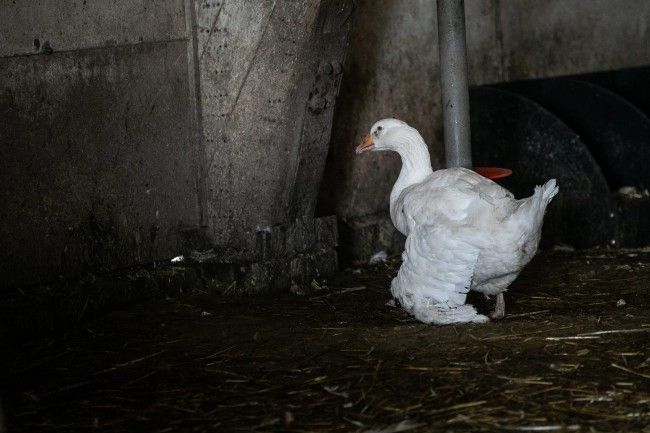

Thankfully, for those seeking alternatives to down, there are an increasing number of technically advanced, cruelty-free options:
| Polyester synthetics | Brands include: Thinsulate, FullRange, PolarTec Alpha and PrimaLoft (used by North Face, Patagonia and Helly Hanson in their down-free ranges.)1Olmsted, A. 2017. Don’t Pluck That Duck: 4 Alternatives To Down. Forbes. Available: https://www.forbes.com/sites/allisonolms/2017/01/17/dont-pluck-that-duck-alternatives-to-down/?sh=2087de6f2582 [Accessed 14 Jan 2021]. IKEA stocks a range of polyester duvets and pillows. |
| Recycled polyester | Made from recycled 100% PET water bottles. Recycled water bottles provide a surprisingly versatile material. Vivo Barefoot has a vegan range of footwear made using it. |
| Lyocell | Made mainly from the pulp of eucalyptus trees so therefore biodegradable. Brands include: Tencel, Newcell and Excel. |
| Bamboo | The fibre from the bamboo is extracted and turned into yarn and other soft material. |
These companies don’t use down, or have a down-free options:
| Nudown | North Face | Patagonia | Nordstrom | Nau | Bight Gear |
| Rab Horizon | Everlane | Columbia Sportswear | Marmot | Save the Duck | Noize |
| Land’s End | Alpine North | Eddie Bauer | Oasis | ASOS | Monsoon |
| Burton | Primark | H&M | Stella McCartney | White Stuff | Warehouse |
| Topshop | IKEA |
Of course, with everything there is a right way and a wrong way to produce materials, so it’s always best to do your research into individual companies to make sure their business practices align with your personal ethics.




